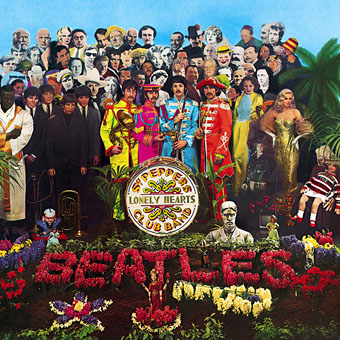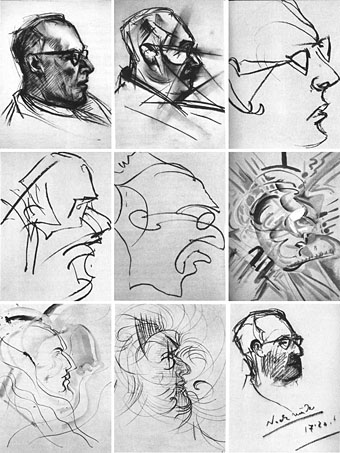Alternative London Olympics logos
Good, bad and ugly.
Category: {design}
Design
Penguin designer David Pelham talks
Penguin designer David Pelham talks
Great lecture about some classic book designs.
A splendid time is guaranteed for all
It was forty years ago today, etc. Sgt Pepper was actually released on May 26th 1967 but June 1st was the official UK release date, June 2nd in the US. Love it or hate it (I love it, of course), popular music has to be divided into “before and after Sgt Pepper” such is the scope of the album’s impact. Yes, many of its vaunted innovations weren’t so unprecedented, yes Abbey Road is better musically, and so on. But it’s unlikely that any album will be so eagerly awaited by so many people, or be so influential, again.
• Song-by-song description from the band members
• Trivia page with parody covers from the Mothers to the Simpsons
• The hip-hop version
Previously on { feuilleton }
• Joe Orton
• Please Mr. Postman
• All you need is…
The art of LSD
Not art inspired by LSD but drawings done whilst under its influence.
These 9 drawings were done by an artist under the influence of LSD—part of a test conducted by the US government during its dalliance with psychotomimetic drugs in the late 1950s. The artist was given a dose of LSD-25 and free access to an activity box full of crayons and pencils. His subject is the medico that jabbed him.
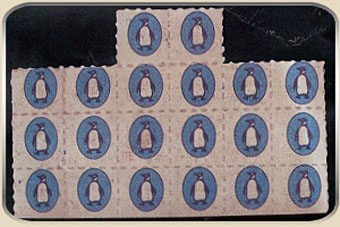
Then there’s the whole world of blotter art, like this fairly recent Penguin logo example. Lots more blotter designs here and here.
Previously on { feuilleton }
• The trip goes on
• Albert Hofmann
• Hep cats
Oh Yeah by Charles Mingus
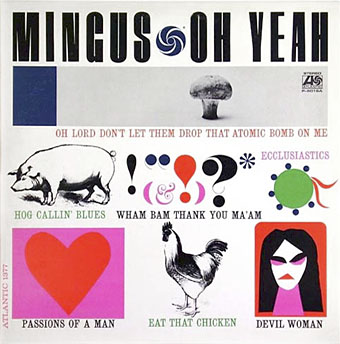
Oh Yeah (1962). Sleeve design by Loring Eutemey.
“People say that I’m hollering. Man, I feel like hollering.” Charles Mingus.
Listening to this great album this week had me searching for the equally great sleeve design from the vinyl edition which vanished from the CD reissue. The cover that replaced it is a dour photo of a gloomy-looking Mingus, completely unsuited to an album full of joyous noise. Happily there’s a Japanese edition that preserves the original design. As far as I can gather Loring Eutemey was a house designer at Atlantic, responsible for many of their jazz sleeves but also providing covers for rock albums including Iron Butterfly’s dumb psychedelic opus, In-A-Gadda-Da-Vida. Lots of playful typography evident in Eutemey’s designs and bold, hand-drawn graphics à la Saul Bass, a style very popular in the Sixties not least because of Bass’s considerable influence.
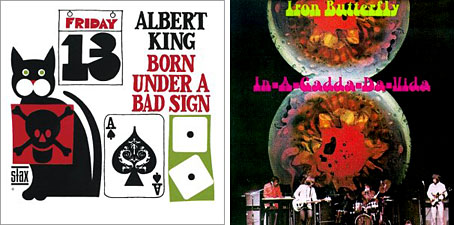
Designs by Loring Eutemey: Born Under A Bad Sign (1967), In-A-Gadda-Da-Vida (1968).
That playfulness especially suits an album where Mingus set aside his bass to play piano and sing (or, more correctly, holler) his way through seven tracks of energetic craziness. There are some amazing solos here from Rahsaan Roland Kirk, a blind musician famous for playing two saxophones at once, one in each hand. The opening Hog Callin’ Blues is one of my favourite jazz pieces, a number where bop rawness approaches the equivalent rawness of Fifties’ rock’n’roll or Chess blues. Always great to play (loud!) to people who think jazz is all polite cocktail music and studied cool. Mingus recorded lots of great albums, of course, and I imagine this is regarded as a throwaway novelty by many of his more dedicated listeners, but it remains one I keep returning to.
Charles Mingus—piano and vocals
Rahsaan Roland Kirk—flute, siren, tenor sax, manzello, and strich
Booker Ervin—tenor sax
Jimmy Knepper—trombone
Doug Watkins—bass
Dannie Richmond—drums
1 Hog Callin’ Blues (7:26)
2 Devil Woman (9:38)
3 Wham Bam Thank You Ma’am (4:41)
4 Ecclusiastics (6:55)
5 Oh Lord Don’t Let Them Drop That Atomic Bomb On Me (5:38)
6 Eat That Chicken (4:36)
7 Passions Of A Man (4:52)
Elsewhere on { feuilleton }
• The album covers archive

